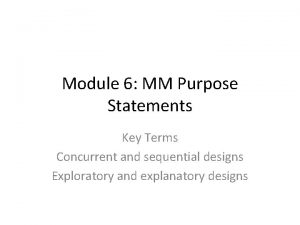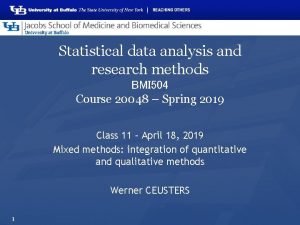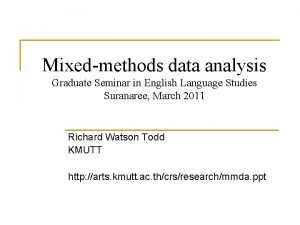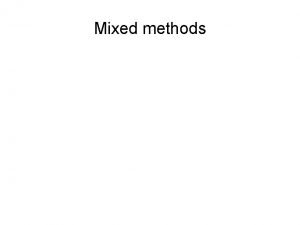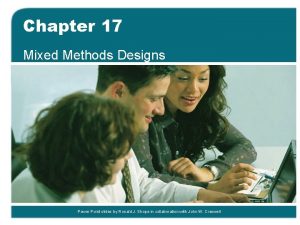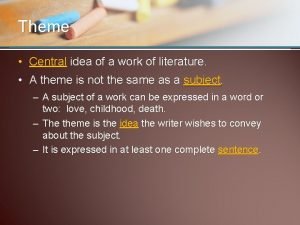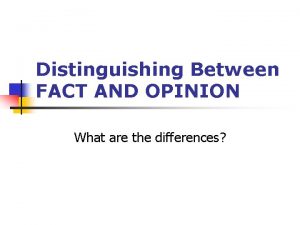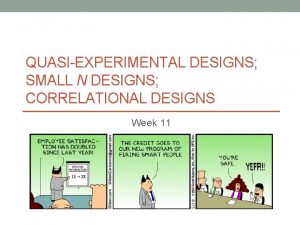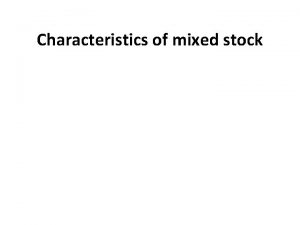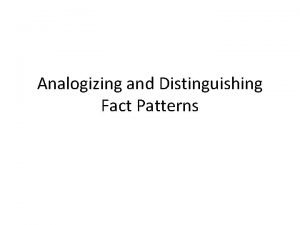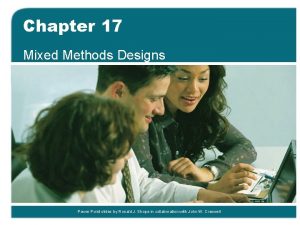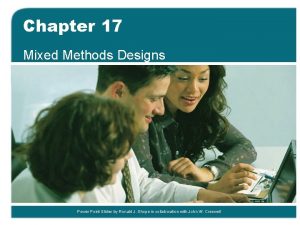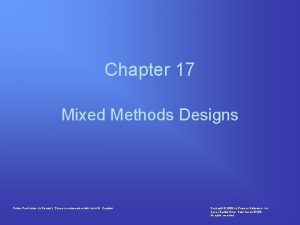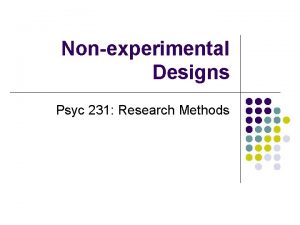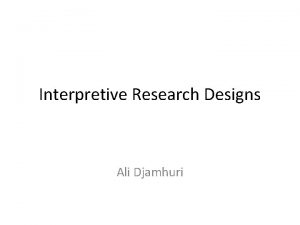Chapter 4 Distinguishing Mixed Methods Designs Purpose To






















- Slides: 22

Chapter 4: Distinguishing Mixed Methods Designs Purpose: To distinguish mixed methods studies by design features like timing and priority.

Goals of the Chapter 1. Present a classification system that distinguishes basic types of mixed method studies. 2. Identify priority as a key feature that distinguishes mixed method studies. 3. Review a widely used notation system that represents timing and priority. 4. Describe the design features of an exemplary publication. 5. Review design features of QUAL, QUANT, and equal priority studies. An Introduction to Fully Integrated Mixed Method Research 2

The Meaning of the Word Design • Design – A thoughtfully constructed link between the purposes of of a research study and the strategies used to implement it. An Introduction to Fully Integrated Mixed Method Research 3

Key Features that Distinguish Mixed Method Design: Priority & Timing • PRIORITY – conventionally defined to distinguish three types of studies: those where the most weight or attention is given to (a) the QUANT phase, (b) the QUAL phase, or (c) where the phases are given equal priority. • A fourth priority: mixed priority is introduced in this chapter. • TIMING – conventionally been conceived primarily in terms of two-phase studies. • refers to the timing of data collection and whether data from the first phase is required in a subsequent phase. An Introduction to Fully Integrated Mixed Method Research 4

Key Features that Distinguish Design: TIMING 1. Concurrent – QUAL and QUANT data are collected simultaneously or independently. 2. Sequential – the research is conducted in two phases with the data collection in the second phase linked in some way on the first phase. 3. Multi-phase – the research is conducted in more than two phases with some interdependence between the phases. An Introduction to Fully Integrated Mixed Method Research 5

Timing- Distinguishing Two-Phase Studies • EXPLANATORY – first phase is quantitative; second qualitative QUANT QUAL • EXPLORATORY- first phase is qualitative; second phase quantitative QUAL An Introduction to Fully Integrated Mixed Method Research QUANT 6

Second Design Feature: Priority • The most weight or attention is giving to 1. QUANT phase 2. QUAL phase 3. Both phases given equal weight An Introduction to Fully Integrated Mixed Method Research 7

The Morse Notation System • Insert Table 4. 2 Morse Notation System An Introduction to Fully Integrated Mixed Method Research 8

Evidence of a Quantitative Priority from Content Analyses of Eight Studies Priority QUANT QUAL EQUAL An Introduction to Fully Integrated Mixed Method Research 9

Explaining the Prevalence of a QUANT Priority • Some mixed methods designs, • QUANT studies are easier to like the development design (for publish and to get funded. instrument development) are inherently QUANT. • Most studies that involve Random Control Trials (RCTs) are inherently QUANT. An Introduction to Fully Integrated Mixed Method Research 10

Priority as a Key Feature of Mixed Method Designs An Introduction to Fully Integrated Mixed Methods Research

Why is Priority Important • Provides a common unit of analysis to compare mixed methods articles. • With timing, a features that is frequently used to distinguish designs. • Points to relevant evaluation criteria. • Contributes to the ability to trace a conclusion to the source of data (or analytical procedure). An Introduction to Fully Integrated Mixed Methods Research

Signs of Priority that Reflect an Overriding Logic* 1. 2. 3. 4. *Title *Reflexive statements about paradigm *Purpose statement *Space allocated to QUAL and QUANT in the results and/or the discussion/conclusions sections. 5. Predominance of methodological language. 6. Weight of QUAL, QUANT, mixing in the final conclusions. An Introduction to Fully Integrated Mixed Methods Research

Mixed Method Studies with Unequal Priority. Characteristics Phase Design Characteristics DESIGN PHASE: Purpose Statement & Presence of only one type of research Research Questions question (QUAL or QUANT) Over-riding purpose that points to QUAL or QUANT dominance INFERENCE PHASE: Meta-inference Major conclusions drawn from either QUANT or QUAL; no meta- inferences INFERENCE PHASE: Discussion and Conclusion Section More space devoted to either QUAL or QUANT An Introduction to Fully Integrated Mixed Methods Research

Mixed Method Studies with a QUAL Priority Phase Design Characteristics DESIGN PHASE: Purpose Statement & Research Questions Focus on the perceptions of participants; strong exploratory phase INFERENCE PHASE: Metainference INFERENCE PHASE: Discussion and Conclusion Section Conclusions derive mostly from QUAL analysis. More space is devoted to the QUAL findings. An Introduction to Fully Integrated Mixed Methods Research

Mixed Method Studies with a QUANT Priority Phase Design Characteristics DESIGN PHASE: Purpose Statement & Research Questions Designed to test theory (confirmatory); interested in the relationship between variables and prediction INFERENCE PHASE: Metainference INFERENCE PHASE: Discussion and Conclusion Section Conclusions derive largely from analysis of QUANT data. More space is devoted to the QUANT results. An Introduction to Fully Integrated Mixed Methods Research

Indicators of Equal Priority Phase Design Characteristics DESIGN PHASE: Purpose Statement & Research Questions Both QUAL and QUANT research questions INFERENCE PHASE: Metainference INFERENCE PHASE: Discussion and Conclusion Section Conclusions derive from both QUAL and QUANT analysis Separate sections address the QUAL and QUANT. May be no mixing. An Introduction to Fully Integrated Mixed Methods Research

Design Features of the Exemplary Publication (i. e. Catallo, Ciliska, & Mac. Millan. , 2013) Design Feature Rationale/Purpose Complementarity Priority Equal Timing of Data Collection Separate, Sequential Timing of Data Analysis QUANT Mixing Fully Integrated- Mixing at all Stages An Introduction to Fully Integrated Mixed Method Research QUAL Qual/Quant 18

Exemplar – The Meta Inference Signals Equal Priority QUANT Conclusion: Women who experienced the most intimate partner violence were least like to disclose it to emergency personnel. QUAL Conclusion: The reluctance to disclose was associated with the fear of stigma. META INFERENCE: Women who experienced the most intimate partner violence were least likely to disclose it to emergency room personnel because of the fear of stigmatization. An Introduction to Fully Integrated Mixed Method Research 19

A Fourth Possible Priority: Some Indicators of a Mixed Priority Design Characteristics DESIGN PHASE: Purpose Statement & Research Questions Contains QUAL, QUANT, and a mixing research questions. INFERENCE PHASE: Metainference Conclusions derive primarily from analysis that blends or mixed QUAL and QUANT data. There is a separate section in the results devoted to mixing. INFERENCE PHASE: Discussion and Conclusion Section An Introduction to Fully Integrated Mixed Methods Research

Review Questions 1. Which mixed method priority (QUAL, QUANT, or EQUAL) is most prevalent? 2. In the traditional notation system, how is priority represented? 3. In the traditional notation system, how is timing represented? 4. How is timing described in studies where QUAL and QUANT data are collected at the same time? 5. How is timing described in studies where QUAL and QUANT data are collected in two different phases? An Introduction to Fully Integrated Mixed Method Research 21

Next Chapter • We shift in the next chapter to the first of three chapters about mixing. • In Chapter 5, the focus is mixing at sampling and during data collection. Jenny Blass, 2016 An Introduction to Fully Integrated Mixed Method Research 22
 Research purpose statement examples
Research purpose statement examples Mixed bags designs catalog
Mixed bags designs catalog Convergent parallel mixed methods
Convergent parallel mixed methods Examples of quantitative research questions and hypotheses
Examples of quantitative research questions and hypotheses Mixed methods research examples
Mixed methods research examples Mixed methods forskning
Mixed methods forskning Mixed methods program evaluation
Mixed methods program evaluation Convergent design mixed methods
Convergent design mixed methods Mixed methods research ppt
Mixed methods research ppt Metode penelitian kombinasi (mixed methods)
Metode penelitian kombinasi (mixed methods) Wax pattern in fpd
Wax pattern in fpd Central idea or message in a work of literature.
Central idea or message in a work of literature. Distinguishing features of kingdom protista
Distinguishing features of kingdom protista Poetic element
Poetic element Similarities between sociology and social work
Similarities between sociology and social work Expanded definition
Expanded definition Main idea/central idea
Main idea/central idea Slidetodoc.com
Slidetodoc.com Example of statement of opinion
Example of statement of opinion Distinguishing between atoms
Distinguishing between atoms Keystream
Keystream Letter and words difference
Letter and words difference Manufacturing accounting basics
Manufacturing accounting basics
